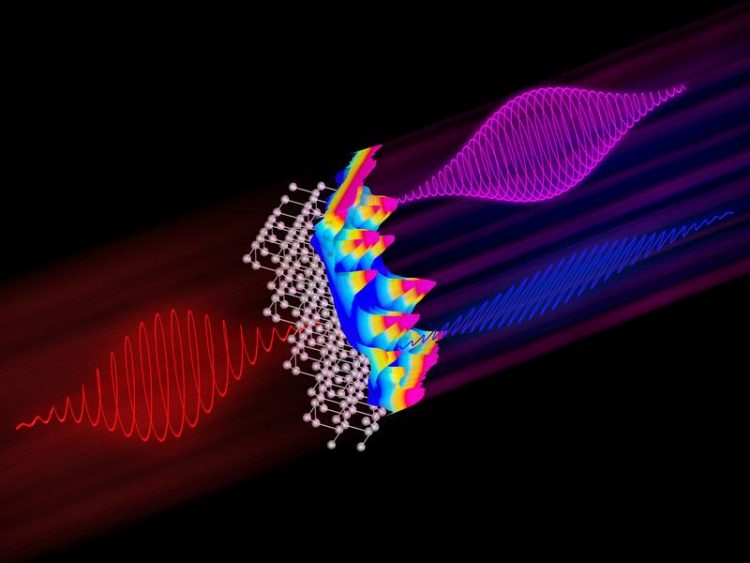The taming of the light screw

An intense laser field (red) interacts with a crystalline solid (white). Higher-order harmonic fields (blue and magenta) are emitted whose polarization states (linear, elliptic or circular) are d Jörg Harms / MPSD
The nonlinear process of high-order harmonic generation (HHG) in gases is one of the cornerstones of attosecond science (an attosecond is a billionth of a billionth of a second) and is widely used in many different areas of science nowadays, ranging from physics to chemistry to biology.
This strong-field phenomenon converts many low-energy photons from an intense laser pulse into a photon of much higher energy. Whereas the HHG process is well understood in atomic and molecular gases, the mechanism underlying frequency conversion in solid materials is currently still the subject of scientific controversy.
By combining HHG experiments and state-of-the-art theoretical simulations, scientists from the Deutsches Elektronen-Synchrotron (DESY) and the Max Planck Institute for the Structure and Dynamics of Matter (MPSD) at the Center for Free-Electron Laser Science (CFEL) in Hamburg now introduce polarization-state-resolved high-harmonic spectroscopy of solids, that permits deeper insights into both electronic and structural dynamics occurring on time scales shorter than one oscillation of the light field. Their work is now published in Nature Communications.
The emitted harmonic fields can oscillate in a linear fashion, or they can rotate elliptically or circularly with clockwise or anticlockwise handedness (so-called helicity) – just like a screw of light. The scientists now reveal how the harmonics’ polarization states and their handedness encode valuable information on the crystal structure and ultrafast strong-field dynamics, and how the harmonics’ polarization states can be controlled.
Moreover, since the harmonics are created within a single period of the incident driving field, the method inherently comes with a sub-optical-cycle temporal resolution.
The present work investigates the prototype materials silicon and quartz to establish the new spectroscopic technique. Yet the method is versatile and expected to find important applications in future studies of novel quantum materials such as strongly correlated materials, topological insulators, and magnetic materials.
Oliver Mücke, senior scientist +49 (0)40 8998 6355
Polarization-state-resolved high-harmonic spectroscopy of solids, Nature Communications
Media Contact
More Information:
http://www.mpsd.mpg.deAll latest news from the category: Physics and Astronomy
This area deals with the fundamental laws and building blocks of nature and how they interact, the properties and the behavior of matter, and research into space and time and their structures.
innovations-report provides in-depth reports and articles on subjects such as astrophysics, laser technologies, nuclear, quantum, particle and solid-state physics, nanotechnologies, planetary research and findings (Mars, Venus) and developments related to the Hubble Telescope.
Newest articles

Innovative 3D printed scaffolds offer new hope for bone healing
Researchers at the Institute for Bioengineering of Catalonia have developed novel 3D printed PLA-CaP scaffolds that promote blood vessel formation, ensuring better healing and regeneration of bone tissue. Bone is…

The surprising role of gut infection in Alzheimer’s disease
ASU- and Banner Alzheimer’s Institute-led study implicates link between a common virus and the disease, which travels from the gut to the brain and may be a target for antiviral…

Molecular gardening: New enzymes discovered for protein modification pruning
How deubiquitinases USP53 and USP54 cleave long polyubiquitin chains and how the former is linked to liver disease in children. Deubiquitinases (DUBs) are enzymes used by cells to trim protein…


